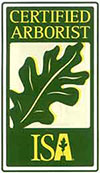Topping Trees - Don't Do It!
The following is a list of reasons why trees should never be topped. A lot of tree services and individuals will top trees rather than properly prune them simply because it is a cheaper and faster process. However, after reading the list below, it should be obvious how much more damage and costs can be incurred when the quick, cheap and easy path is taken.
The ISA is very clear on the detriment to trees when topped. They even go so far as to revoke an aborist's certification when caught topping trees instead of properly pruning them.
Starvation: Good pruning practices rarely remove more than 1/4 to 1/3 of the crown, which in
turn does not seriously interfere with the ability of a tree’s leafy crown to manufacture food.
Topping removes so much of the crown that it upsets an older tree’s well-developed crown-to-root
ratio and temporarily cuts off its food-making ability.
Shock: A tree’s crown is like an umbrella that shields much of the tree from the direct rays of
the sun. By suddenly removing this protection, the remaining bark tissue is so exposed that
scalding may result. There may also be a dramatic effect on neighboring trees and shrubs. If
these thrive in the shade and the shade is removed, poor health or death may result.
Insects and Disease: The large stubs of a topped tree have a difficult time forming callus.
The terminal location of these cuts, as well as their large diameter, prevent the tree’s chemically
based natural defense system from doing its job. The stubs are highly vulnerable to insect
invasion and the spore of decay fungi. If decay is already present in the limb, opening the limb
will speed the spread of the disease.
Weak Limbs: At best, the wood of a new limb that sprouts after a larger limb is truncated is
more weakly attached than a limb that develops normally. If rot exists or develops at the
severed end of the limb, the weight of the sprout makes a bad situation even worse.
Rapid New Growth: The goal of topping is usually to control the height and spread of a tree.
Actually, it has just the opposite effect. The resulting sprouts (often called water sprouts) are
far more numerous than normal new growth and they elongate so rapidly that the tree returns
to its original height in a very short time-and with a far more dense and dangerous crown.
Tree Death: Some species of trees are less tolerant to topping than others. Beeches, for
example, do not sprout readily after severe pruning and the reduced foliage most surely will
lead to death of the tree.
Ugliness: A topped tree is a disfigured tree. Even with its re-growth it never regains the
grace and the character of its species. The landscape and the community are robbed of a
valuable asset.
Cost: To a worker with a saw, topping a tree is much easier than applying the skill and
judgment needed for good pruning. Therefore, topping may cost less in the short run.
However, the true costs of topping are hidden. These include: reduced property value, the
expense of removal and replacement if the tree dies, the loss of other trees and shrubs if they
succumb to changed light conditions, the risk of liability from weakened branches, and
increased future maintenance.

